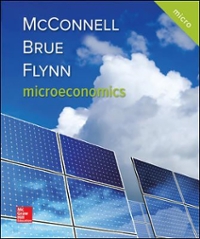Question
Microeconomics / Carbon tax Australian carbon scheme The class introduced the effects of the introduction of a carbon scheme approved few years ago by the
Microeconomics / Carbon tax
Australian carbon scheme
The class introduced the effects of the introduction of a carbon scheme approved few years ago by the Australian parliament.
In the first phase of the scheme, a tax on carbon of AU$25 per ton of carbon emitted is imposed on the 500 largest polluting firms emitting 500 million tons of carbon per year (before the tax is introduced).
In the second phase of the scheme, a cap and trade system is introduced instead of the carbon tax.
(a) The Australian government predicts that the carbon tax will reduce the quantity of emission by
100 million tons per year. How much will be the government revenue for this tax?
(b) In order to minimize the negative impact of this tax on the Australian firms, the government has designed some compensation packages. Assume that the government uses all the revenue from the carbon tax to compensate the 500 firms. why the 500 firms are still worse off?
(c) Does the carbon tax that the Australian parliament approved, generate a deadweight loss?
(d) Now consider the following three firms. After the introduction of the tax, firm 1 reduces emissions of carbon by 2 million tons (that is, it abates 2 million tons or A1 = 2); firm 2 reduces emissions of carbon by 500,000 tons (that is, it abates 500,000 tons or A2 = 0.5); firm 3 does not reduce emissions at all (that is it abates zero or A3 = 0).
What is the marginal cost of abatement of firm 1 of abating 2 million tons, that is MC1(A1)?
What is the marginal cost of abatement of firm 2 of abating 500,000 tons, that is MC2(A2)?
What is the marginal cost of abatement of firm 3 of abating zero tons, that is MC3(A3)?
(e) Now assume that the prediction of the government is correct and that after the introduction of the carbon tax, the emissions of carbon decrease to 400 million tons per year. In the second phase of the carbon scheme, the carbon tax is eliminated and the government allocates 400 million carbon permits which allow emissions of 400 million tons of carbon to the firms. Those permits can be bought and sold in a national market (cap and trade). If nothing else changes between the first and the second phase of the carbon scheme, what is the price that you expect to observe in the market for carbon?
(f) Keep assuming that the government allocates 400 million carbon permits. Can you determine the quantity of emissions each firm in part d) will abate?
(g) We now make the assumption that the carbon scheme (either carbon tax or cap and trade) results in higher variable costs for the Australian firms. More specifically consider the following firm (producing beer) with cost structure:
Before the carbon scheme: fixed costs=1 (nonsunk) and variable costs equal V C(q) = 4q2.
After the carbon scheme: Fixed costs=1 (nonsunk) and variable costs equal V C(q) = 9q2
i) Assume that the market for beer is a competitive market. If the price for beer is p = 36, what
is the quantity of beer supplied before the carbon scheme and after the carbon scheme?
ii)Derive the firm supply function before the carbon scheme and after the carbon scheme.
Illustrate graphically.
iii)Assume that in the beer market there are 10 identical firms. Derive the market supply function
for beer before and after the carbon scheme.
iv)Assume that the demand for beer is downward sloping. In a diagram representing the beer
market illustrate the equilibrium price and quantity before and after the introduction of the carbon tax. Illustrate the change in consumer surplus in the market for beer caused by the introduction of a carbon system.
Step by Step Solution
There are 3 Steps involved in it
Step: 1

Get Instant Access to Expert-Tailored Solutions
See step-by-step solutions with expert insights and AI powered tools for academic success
Step: 2

Step: 3

Ace Your Homework with AI
Get the answers you need in no time with our AI-driven, step-by-step assistance
Get Started


